

Thomas Cook’s timetables have been the go-to resource for the international rail traveller for nearly 150 years. Since 2013, the timetable has been published by European Rail Timetable, a management buy-out, with whom Timetable World is partnering.
The Thomas Cook Group has changed ownership many times over the years and was even publicly owned for a time up to the 1960s. It evolved into a full-service tour operator, with shops, package holidays, financial services, and an airline, but was weighed down with debt. The group went into receivership in 2019.
There were happier times in the 1970s, when the timetable reached its centenary, and in the 1980s when an Overseas Edition was launched, separating out the European and non-European railways. We have the first full Overseas edition of 1981 – the one following a “pilot” edition.
The March 1973 Centenary Edition, signed by J H Price, the editor, contained a special historical section. We have adapted it for presentation here as part of the digital archive. Since the liquidation of Thomas Cook Group, it is unclear where the copyright resides - we have asked the receivers - but it is offered here as a public service.
To access all the Thomas Cook's timetables in the collection, choose the Timetables + International menu.
March 1973: Title page, signed by J H Price, Editor.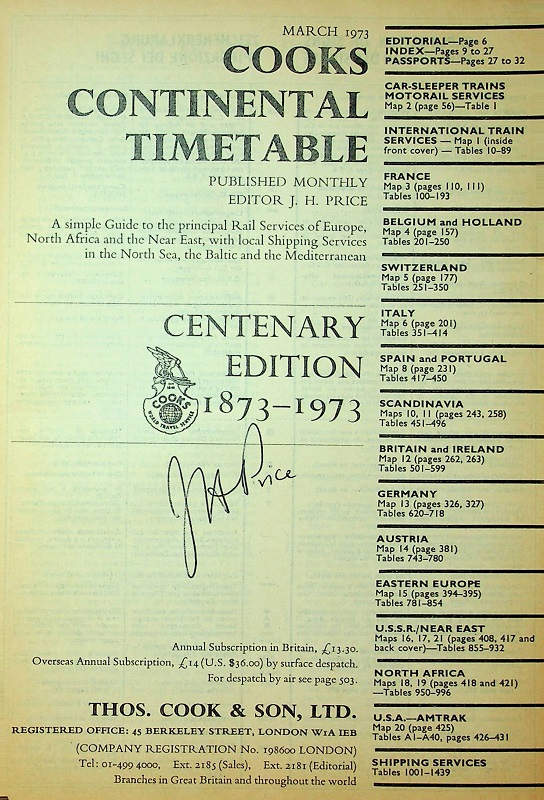
The 1973 cover is a 2-4-2 express locomotive of the former Paris, Lyons and Mediterranean Railway (PLM), one of about 400 generally similar engines built in the company’s workshops at Paris, Oullins and Arles between 1877 and 1889. These locomotives weighed about 47 tons, and had driving wheels 6ft. 10.75in in diameter. They worked the principal trains between Paris and the French Riviera until the turn of the century, and continued in local service on PLM lines until the 1920s. The drawing is based on a 1901 view of the Calais-Mediterranean Express at the frontier station of Ventimiglia.
The locomotive is shown against the face of a Fusee Lever watch made by hand in a Clerkenwell workshop in 1873. This type of key wind pocket watch was commonly used by railway guards one hundred years ago, and has gilt ornamental design with gold figures on a silver face.
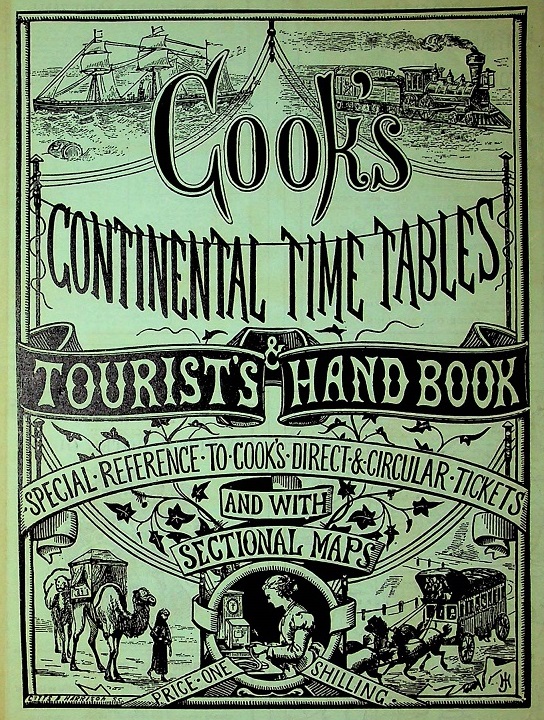
March 1873: Originally printed on orange paper
In 1873, Thomas Cook and Son’s tourist office in London was to be found at 107, Fleet Street, in premises shared with Professor and Mrs. Fowler’s Phrenological Consulting Rooms. It was here that the first issue was published of Cook’s Continental Time Tables and Tourist’s Handbook.

Cook's timetable was not the first British publication to give the times of trains on the Continent. That honour belonged to Bradshaw’s Continental Guide, first published in 1847, which grew to a huge unwieldy volume of more than a thousand pages and tried to show every line of railway, plus a 400-page hotel directory. John Bredall, a Cooks employee who was later to become company secretary, saw a need for a handy, condensed Continental timetable which travellers could carry with them, and put the idea to John Mason Cook, son of the founder. The suggestion was adopted, and in March 1873 appeared the first-ever issue of Cook's Cheap, Concise and Simple Guide to All the Principal Lines of Railway, Steamers and Diligences on the Continent of Europe. By careful selection of services and stations, and an economical layout, John Bredall succeeded in producing a true pocket timetable of 140 pages, for which he received £25.
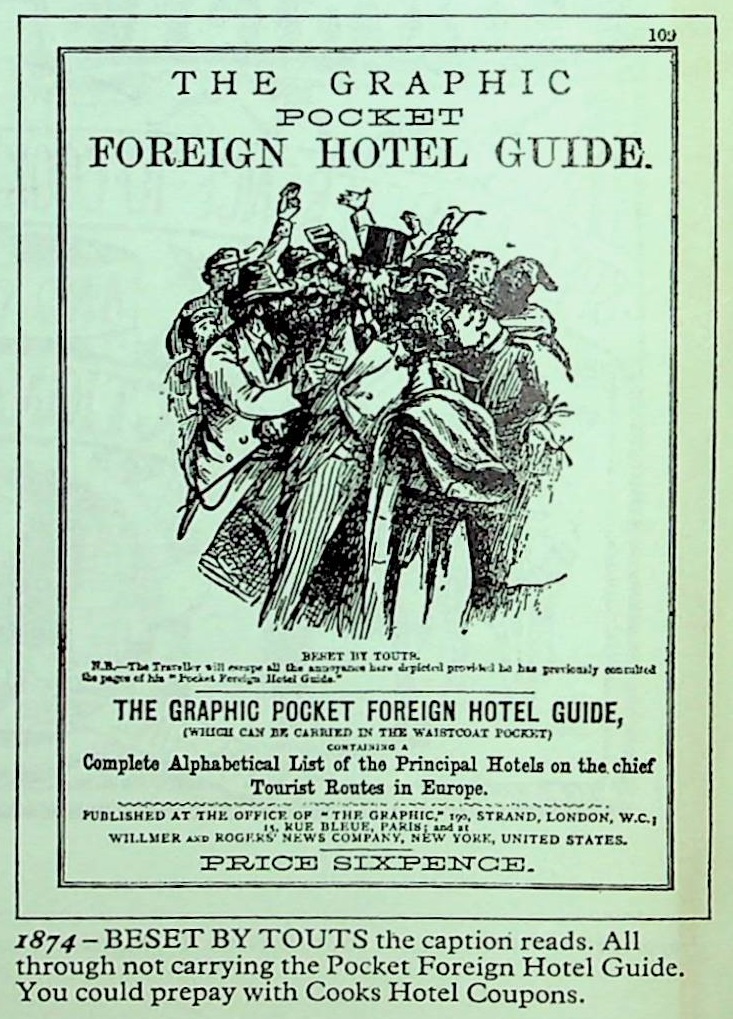
The first issue appeared early in March 1873 and was produced mainly to attract advertising and subscriptions in readiness for the start of regular publication in June. Press comment was uniformly favourable, and from June 1873 the timetable appeared four times per year at a price of one shilling, of which John Bredall received one penny per copy sold. The timetable was printed by Cooks in the basement of their new London office; Thomas Cook had been in the printing trade, and the firm produced its own posters, handbills, and a monthly journal, the Excursionist. The cover of the timetable was printed on an orange paper, as has every issue since then, excepting the present one.
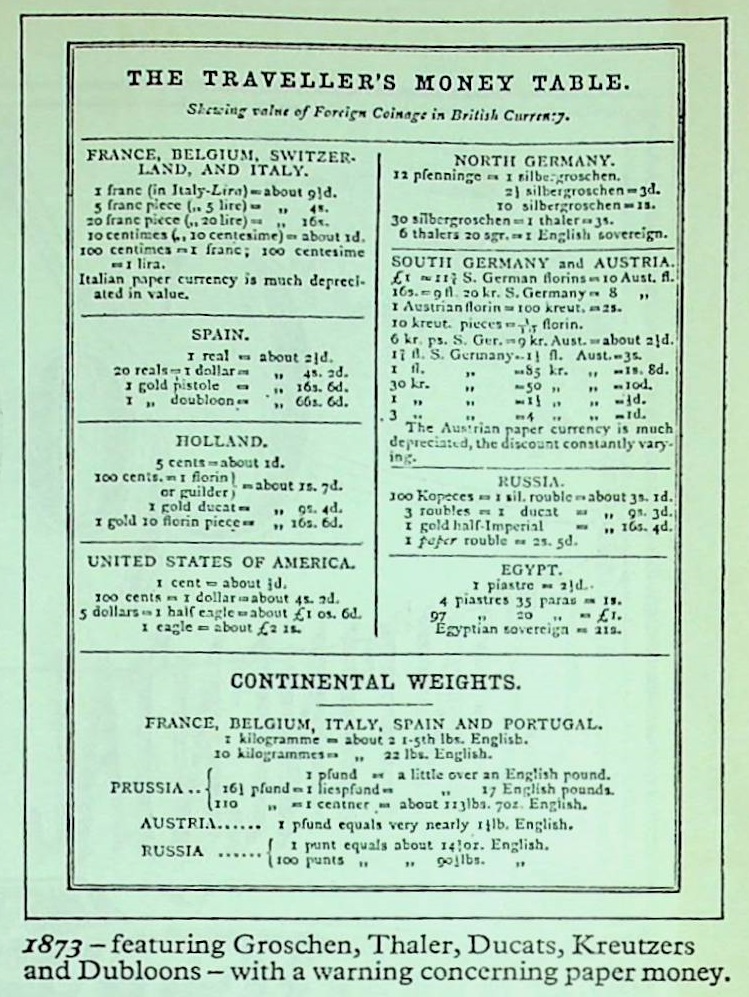

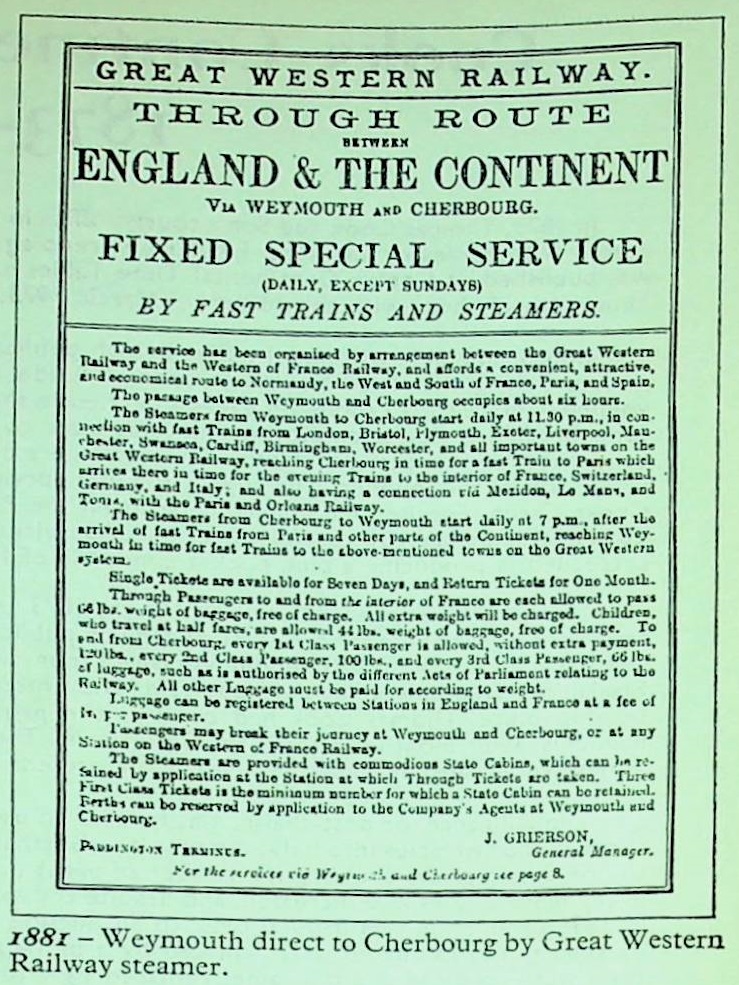
As new railways were opened, the timetable grew, doubling its number of pages in twenty years, and from January 1883 it was published every month. Sales also increased, and despite the extra pages the price was kept at the original one shilling, in 1896 production was handed over to an outside printer (Thos. Forman) and in 1900 the original cover, by then somewhat dated, was replaced by a more modern design by W. C. Keene, in which the ship and train were up-dated and the camel replaced by a Rhine steamer. This 1900 cover survived until November, 1919, as did the 1 shilling [5p] selling price.
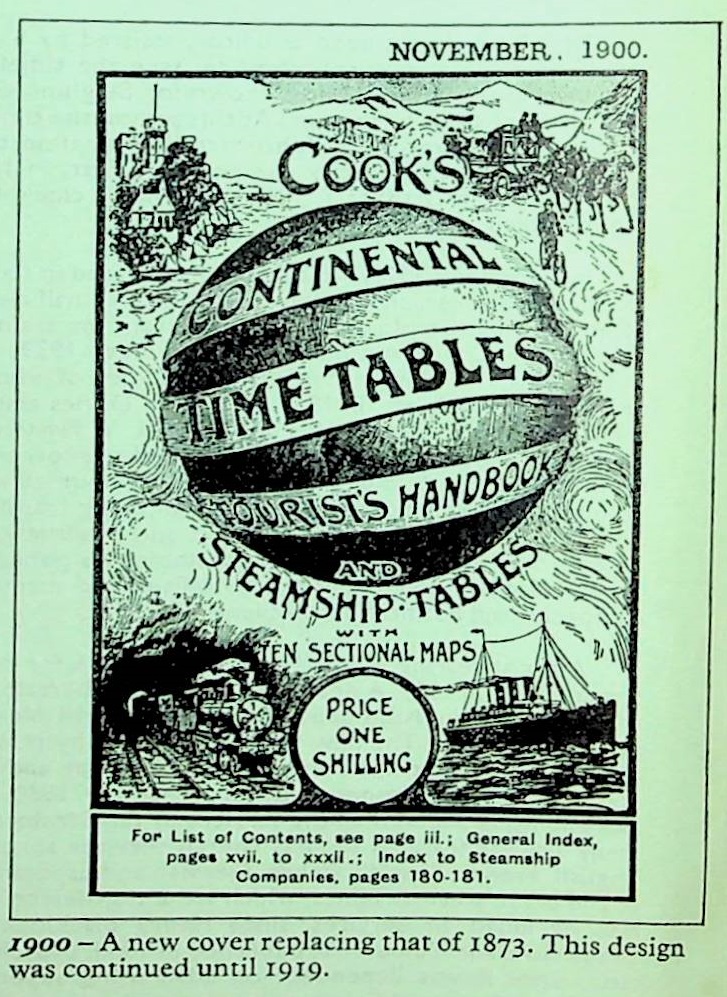
The Diligence, or post-chaise, was familiar to users of the 1873 timetable, for there was then no railway through the Swiss alps into Italy; the first (the Gotthard tunnel) opened in 1882.
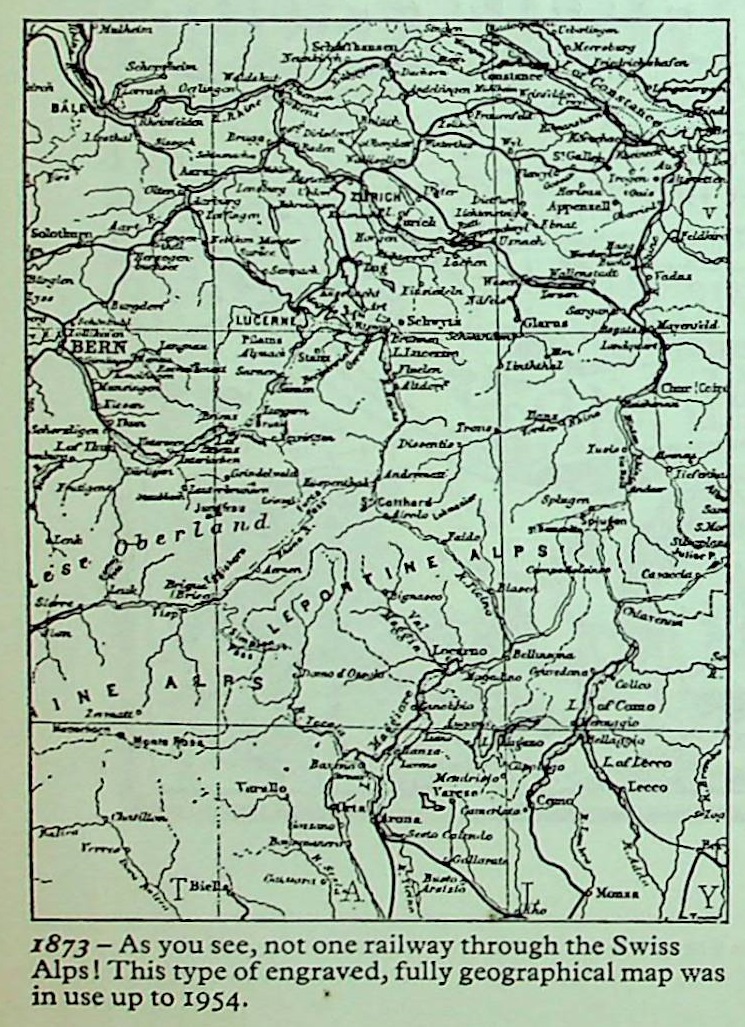
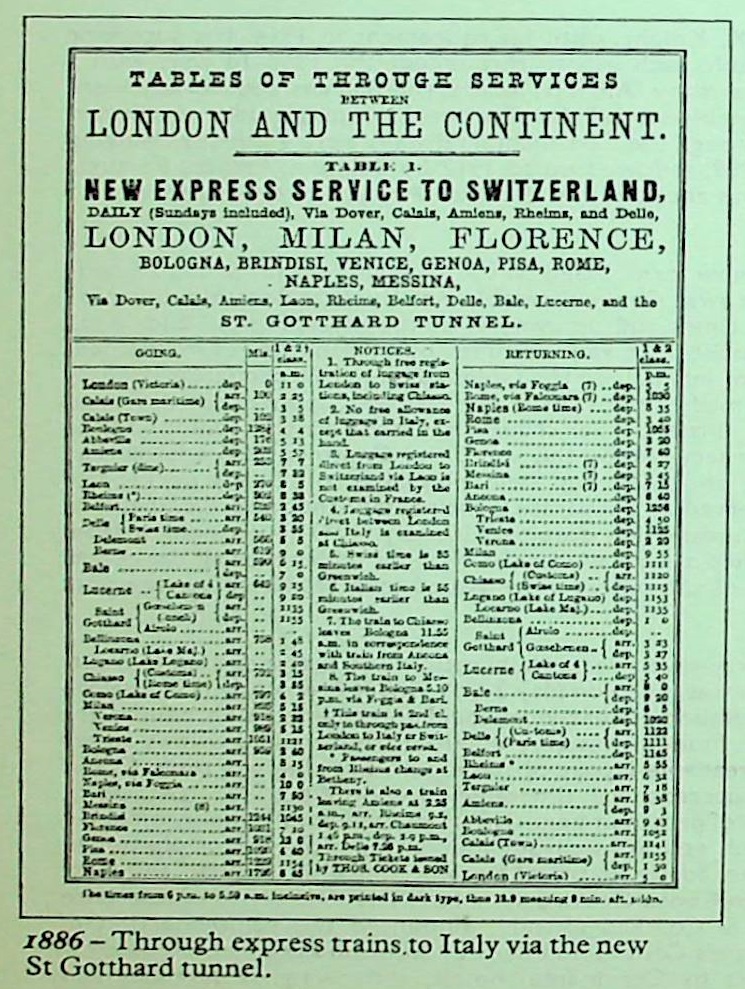
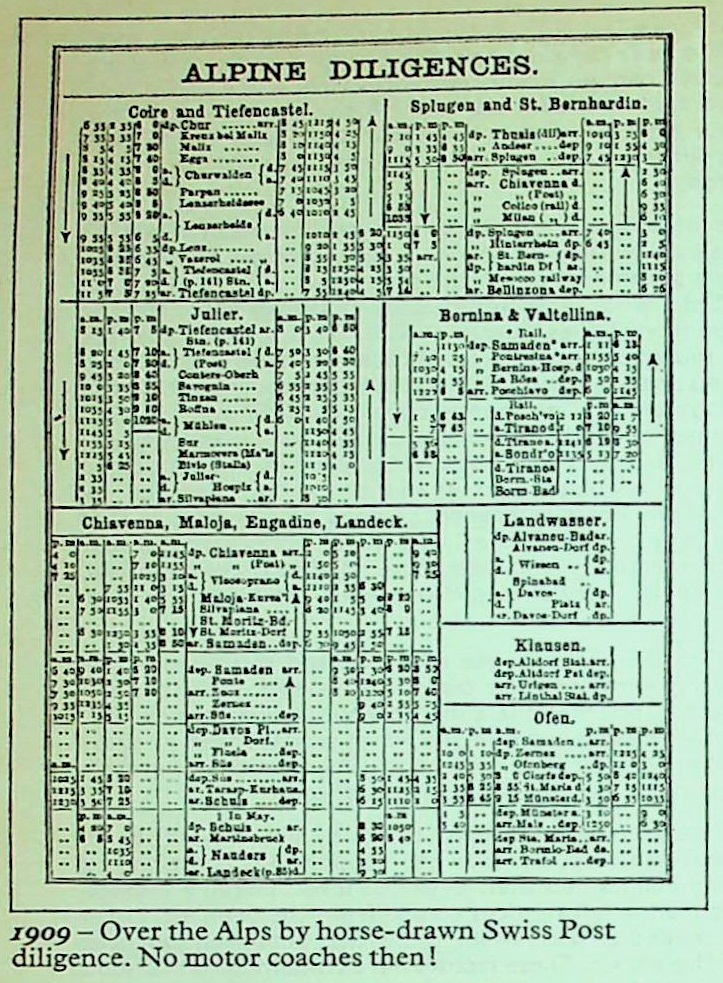
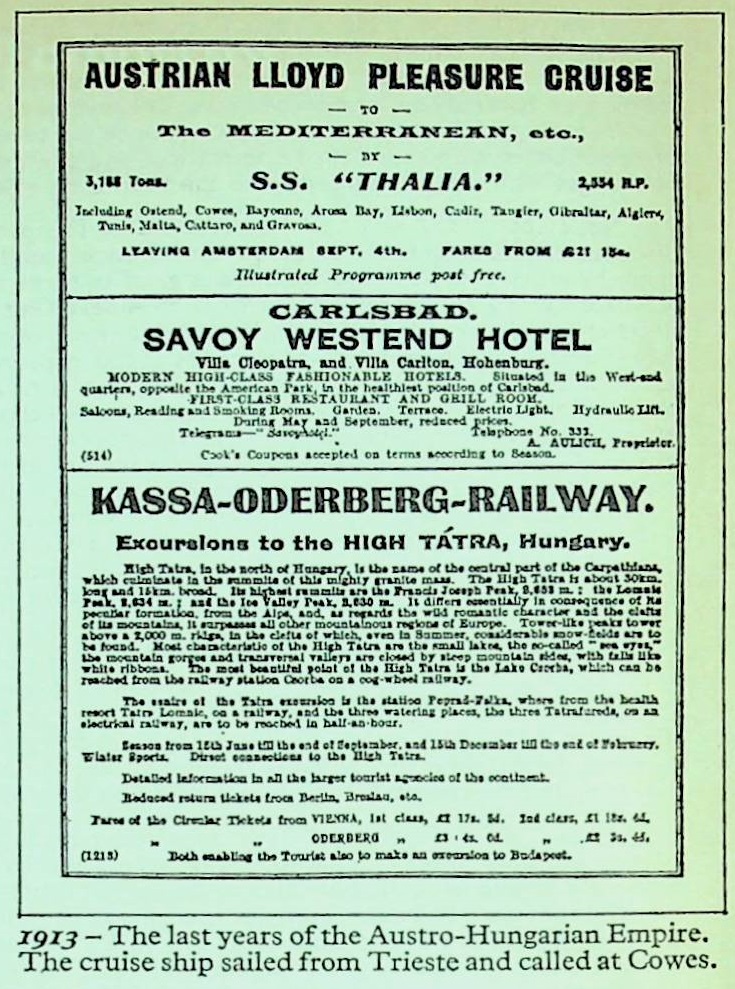
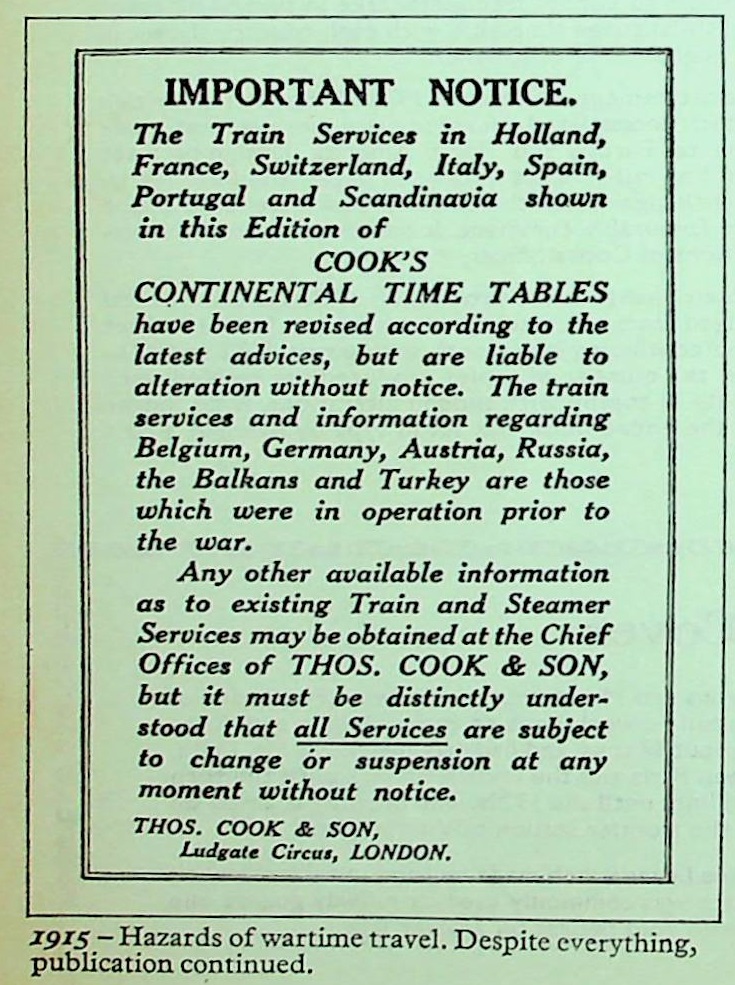
John Bredall continued as editor, assisted by S. K. Knight, until his retirement in 1914. His successor was C. H. Davies, who contrived to issue the timetable each month throughout the 1914-18 war, with a warning note that the services shown for Belgium, Germany, Austria, Russia, the Balkans and Turkey were those in force prior to the war. At this period the timetable served also as a world shipping guide, not limited to Europe. Services were still shown in 12-hour time, though the Continental railways were gradually changing to the 24-hour system; Italy was probably first, in 1898, followed up to 1912 by Belgium, France, Portugal and Spain. From October I, 1918 the 24-hour clock was adopted in the British Army, and Cooks decided to use it in their timetable.
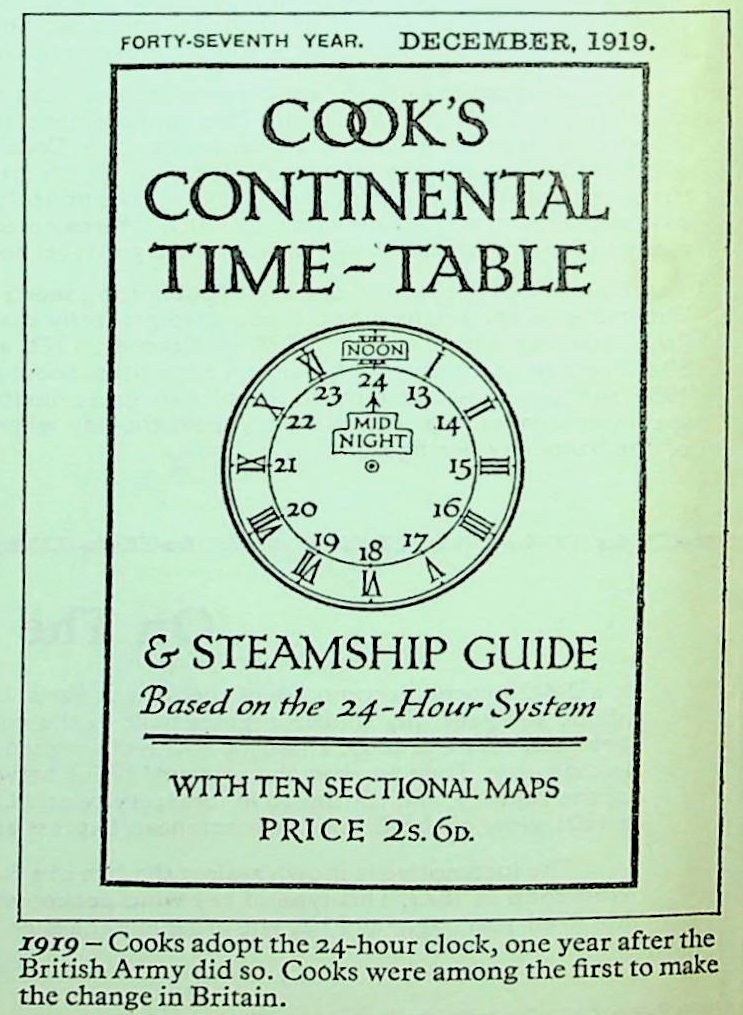
In December, 1919, the timetable appeared in its new form, based on the 24-hour system, with a 24-hour clock on the cover, and the price increased to half-a-crown. Cooks timetable was the first British publication to adopt this now almost universal system for train times and do away with the myriad ‘a.m.’ and ’p.m.’ notes. C. H. Davies continued as editor until 1939, assisted at various times by F. Bannock, H. V. Francis, J. Harmshaw, H. Smallburn and others, each of whom maintained the tables relating to a particular country or means of transport. In 1937, Mr. C. H. Davies assumed the post of Traffic Manager, and most of the timetable data was collated by his assistant, H. V. Francis. Little further change was made to the content of the timetable, though a few pages were added to show air services. By this time, the Continental Bradshaw had followed Cooks example, changing to 24-hour time and reducing their timetable to a handy pocket-size volume, the former descriptive material being transferred to a separate Continental handbook. Competition between the two publications, Cooks and Bradshaw, meant that despite a January, 1937 price increase from 2s. 6d. to three shillings, Cooks timetable was published at a small loss. At that period, about half the copies produced were used in Cooks own offices, and many of the others were issued free of charge to transport companies and business house clients of Cooks.
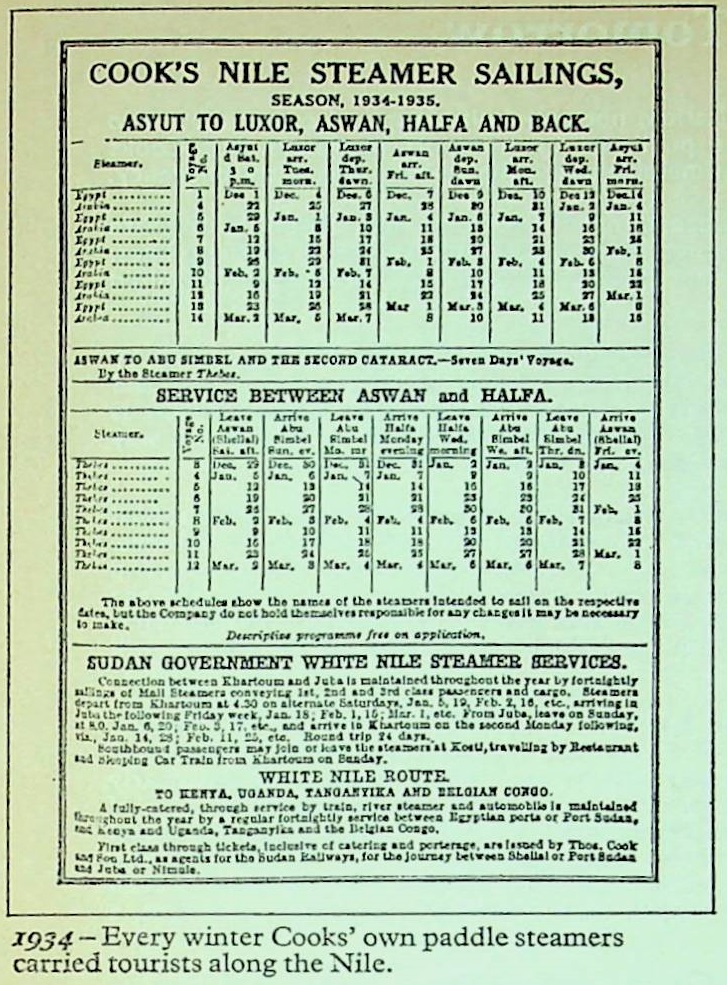
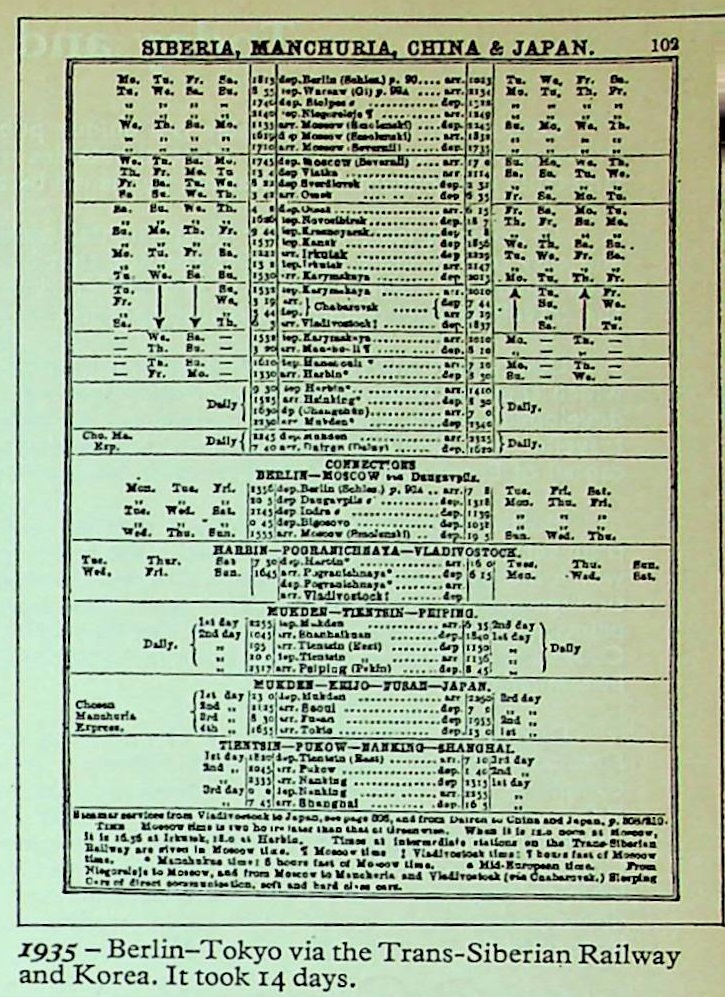
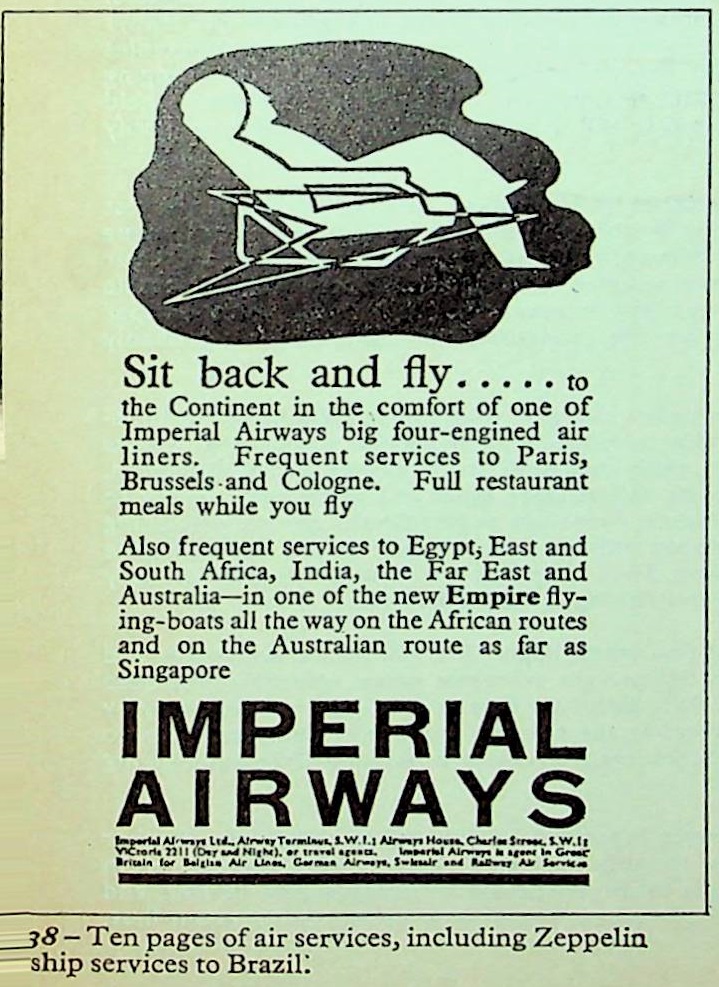
After appearing regularly without a break for sixty-seven years, publication was suspended on the outbreak of war in 1939. A decision to resume publication was taken on May 28, 1945, but it was July, 1946 before the first postwar issue appeared, and not until November of that year could the timetable be offered for sale to the public. The new timetable, edited by H. V. Francis, was very different from the old, with a larger format chosen to permit an exceptionally clear and readable layout of the tables. For the first time, Cooks adopted the picturesque and very effective 1930 international timetable symbols and identified the services by table instead of page numbers. The new book was thinner, omitting many prewar features such as church services abroad, golf links throughout Europe, the list of phrases in English, French, Spanish, Italian, German and Esperanto, advice on travel clothing, a Jewish calendar, and most of the ocean steamer tables, which were transferred to Cooks Ocean Sailing List. The 1945 terms of reference also excluded air services, since Henry Blacklock & Co. had already announced the reintroduction of Bradshaw’s Air Guide, first published in 1934. Bradshaw’s Continental Railway Guide did not resume publication, since it was dependent on advertising support by Continental hotels, and owing to currency and travel restrictions this was no longer generally available.
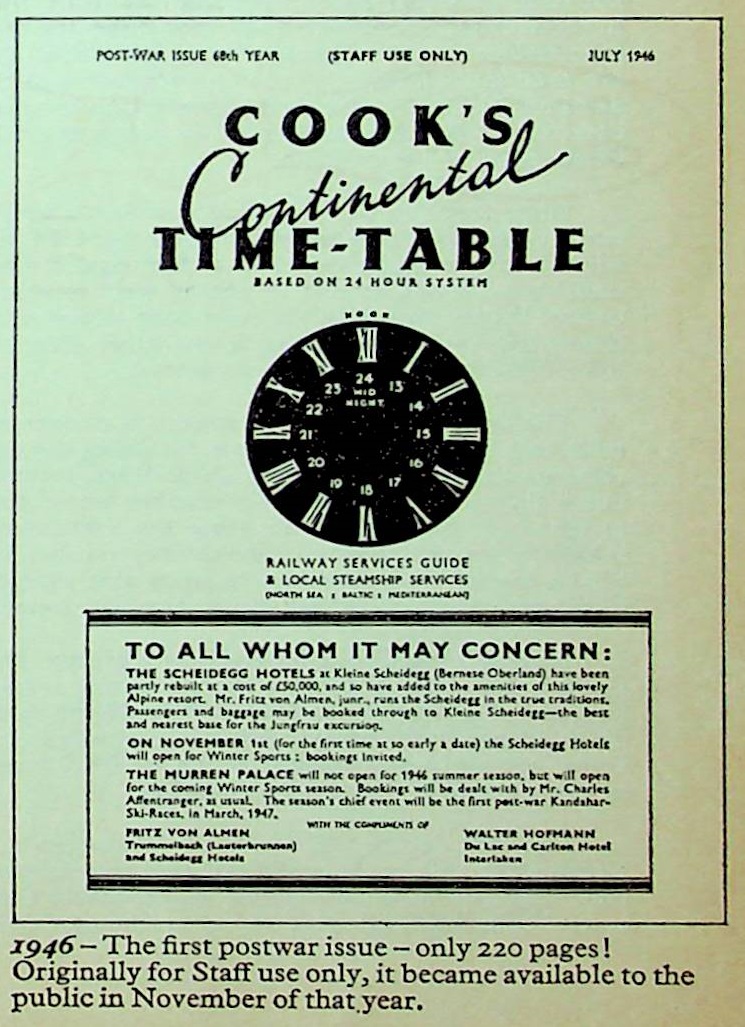
From November, 1946, Cooks Continental Timetable was on sale to the public at five shillings, soon increased to six shillings and then to 7s. 6d. as the Continental railways recovered from the war and pages were added. The passport pages of the early postwar issues contain many references to the need to obtain military or control commission permits, and several important railways such as the Mont Cenis route or the link from Yugoslavia to Greece did not reopen for several years. New postwar features included plans of the principal cities with more than one station, and the introduction of a monthly editorial page to give details of changes which had occurred since the preceding edition.
November, 1952 saw the appointment of the present editor, J. H. Price, whose first reform was to discontinue the engraved full-geographical maps supplied since 1873 by W. & A. K. Johnston and replace them by more prosaic line diagrams designed to serve as a graphic index. In the same year, 1954, production was transferred to the Grimsby works of Albert Gait Ltd., who had printed most of Cooks vouchers and hotel coupons since the 1860s, and the fount was changed from Times Roman to Gill. For the first time, the table numbers were shown along the lines of the map, an improvement which made the timetable considerably easier and quicker to use. This was soon reflected in rising sales, which by 1956 had reached about three times prewar figures. June, 1956 saw the change to a tv/o-class system on Continental trains, and 1957 saw the start of the Trans-Europe Express network. The popular summer service supplement in the Spring issues began in a small way in 1955 and took on its present form in 1958, in which the tables of the principal international trains appear a second time at the back of the book to give advance notice of summer service changes. By including these pages in the regular monthly editions, suitably cross-referenced, Cooks help to ensure that intending travellers are quoted timings correct for the date on which they will travel. 1958 saw the first Continental car-sleeper train, from Boulogne to Lyons; this feature alone now requires almost twelve pages, with their own map. Train numbers, hitherto shown sparingly, were shown throughout the timetable from 1954/55.
August, 1956 saw the reopening to tourists of the Trans-Siberian route to Japan, and this page is one of the most popular features of Cooks timetable, particularly with armchair travellers. Further additions and a general rise in printing costs forced Cooks to increase the price of the timetable successively to 8s. 6d., I Os. 6d. and 12s., and in the face of rising postal charges, the present lightweight paper was adopted in 1959. By enabling the timetable to be sent overseas economically by airmail, or air freight, this feature has greatly extended the overseas sale, which now accounts for almost two-thirds of all copies produced.
When Cooks Continental Timetable resumed publication in 1946, tourist travel by air was still in its infancy and most international journeys were made by rail and ship. By 1965 the proportions had changed decisively in favour of air, but sales of Cooks rail timetable maintained their previous level. Enquiry showed that the timetable had assumed a new usefulness in giving feeder rail services to and from the principal cities served by air, and that overseas visitors flying to Europe tended to use rail for their local European journeys to make the most of the sightseeing opportunities during their tour. These factors have combined to maintain the monthly sale at a level far above that of 1939, and a notable feature of recent years has been the rapid rise in sales to visitors to Europe from Japan. The overseas visitors to Europe frequently take in several different countries, and the availability of a concise, combined English-language timetable with each country shown in a standard form helps to promote tourist movement throughout the continent.
The principal change of recent years has been the reinstatement in January, 1970 of the former British rail tables, in a more modern form. This improvement, which necessitated a further price increase, was made in response to demand from abroad, particularly Continental Europe and North America. Designing a set of tables that would show almost all British and Irish main line rail services in only 64 pages (the limit set by the airmail postage rates) was perhaps the most difficult challenge which the editorial staff have faced in the past decade, and the result attracted much interested and favourable comment. It has also helped the interchange of staff between the British and foreign travel sections of Cooks offices.
The start of the second century of publication sees a basic change in the production of Cooks Continental Timetable, as the sections of the book are gradually changed from the traditional letterpress form to offset litho, starting with pages 297-328 in October, 1972, and continuing last month with pages 1-32 and 473- 504. Further sections will be changed to litho soon, as the number of copies produced has trebled since 1954 and the previous method, despite its great flexibility in coping with sudden alterations, is no longer the most economical. It is a far cry from the day when the entire book was set in type by hand, at a cost of one halfpenny per figure.
--- as written in 1973
Cooks Continental Timetable is a unique publication, not only in its form and content, but also in its sponsor and publisher. Most timetables are published by transport operators, but Cooks timetable is a consumer publication, published by a timetable user—the world’s largest travel agency.
To compile itineraries for their clients, travel agents need timetables that are quick, accurate and easy to use. Long ago, Cooks realised that by designing a European rail timetable on these lines, they could help their own staff to save time and prevent mistakes. What suited Cooks staff also suited the travelling public, and this is just as true today.
Cooks have always been in a unique position to know where travellers go, and the routes by which they go there. They knew that there was no need to show every station, or every line, and developed a happy knack of including in the timetable all the services that any but the mos adventurous traveller was likely to want, without wasting space on local or suburban stations. Only in this way can all of Europe be compressed into a timetable weighing less than one pound.
Most of the information in the timetable is sent to Cooks by the different railways. International train services in Europe are decided by the International Timetable and Through Carriage Conference, which meets in October to decide the new services to apply from the next summer. The minutes and timings appear in November, and work then begins on next summer’s timetable, starting with the principal international trains which Cooks publish as an advance summer supplement. By February, Cooks know whether they will have to make changes in the table layout, or whether the pattern will be similar to that of last year.
During January and February, the railways send Cooks the first proofs of their own timetables. First to arrive are those for Britain, followed by Austria, Holland and Switzerland, and Cooks begin compiling their own pages. Sometimes an existing page can be used with amendments, but nearly 300 pages have to be reset every year. Proofs are taken in green ink on white paper, for ease of correction. The tables are laid out in a form corresponding generally with the rules of the International Union of Railways, with standard international symbols, except that lack of room prevents Cooks from putting a space or symbol between the hours and minutes. Much space is saved by showing both directions of travel on the same table, reading downwards on the left and upwards on the right, a feature of Cooks timetable since 1873.
Some railways, such as Spain, Portugal, Turkey and those of North Africa and the Near East, do not issue timetable proofs; some do not even issue booklet timetables, but rely on station posters. In these cases, Cooks send their own pages for the railway to revise, but the changes are not always predictable, and here Cooks are greatly helped by their own local offices. The shipping timetables are even more flexible, as the operators change their routes and schedules in response to changing demands. Monthly publication is essential to keep up with this, and the shipping pages are always held back to the last possible date before going to press, but it still happens that operators fail to notify Cooks of sudden alterations.
Since October, 1954, Cooks timetable has been printed by Albert Gait, Ltd., who stock the largest range of foreign accents and timetable symbols of any British printing house. Their capacity to cope with massive sudden alterations to the pages is vital in keeping Cooks timetable up to date, and their staff have become expert in coping with foreign place-names, accents, and space-saving timetable layout. Where new features have been added or expanded in recent years, such as the car-sleeper trains, this has meant closing up the other data into a more condensed form, and Cooks is probably the most dose-packed of any timetable.
The reason for this is the structure of overseas postal charges, which effectively limit the timetable to a maximum of 520 pages, including the popular advance summer service supplement. Cooks receive many suggestions from subscribers, including their own staff, for additions to the timetable, but if they were adopted the timetable would soon be half as large again and much more costly to produce and despatch. Apart from the sponsored North American pages, Cooks get no publishing subsidy from the railways (though they receive precious railway help in other ways); the timetable has to pay its way from sales revenue plus advertising. That it does is a source of wonder to many transport operators, whose experience of timetable publishing is very different.
At one time. Cooks timetable was printed on a fine white paper, but publishing economics and rising postal rates brought a change to the present lightweight off-white paper, specially produced for Cooks by Peter Dixon Ltd., at West Marsh Paper Mill, Grimsby. Copies produced and sold vary by up to 40 per cent between summer and winter, reflecting the seasonal pattern in overseas travel to Europe; the mid-winter figure of around 10,000 copies per month rises to nearly 13,000 in June, giving an annual total In the region of 126,000.
The next decade will see further timetable changes; miles will be changed to kilometres, further place-names will be de-anglicised, and metric postal weights may well affect the book’s size. From May, 1980, the Channel Tunnel will probably bring a major re-casting of international routes and several other high-speed railways are planned. Our second century could well be as eventful as our first.
Postscript: The 1973 Channel Tunnel project was abandoned in 1975, with one mile built. The project was resurrected in the early 1980s and services finally began in June 1994.